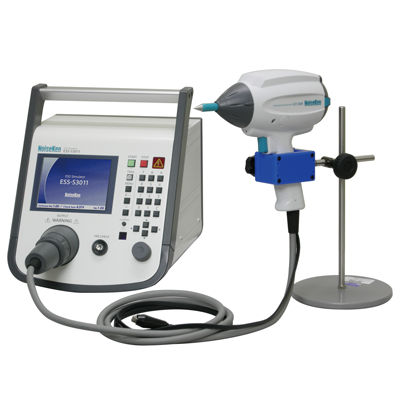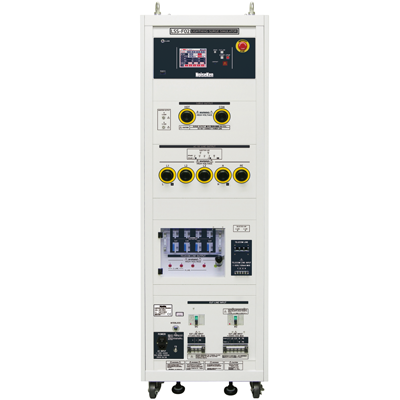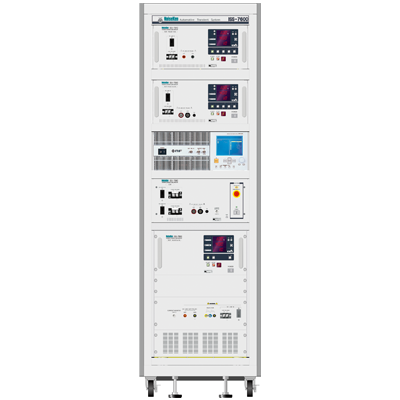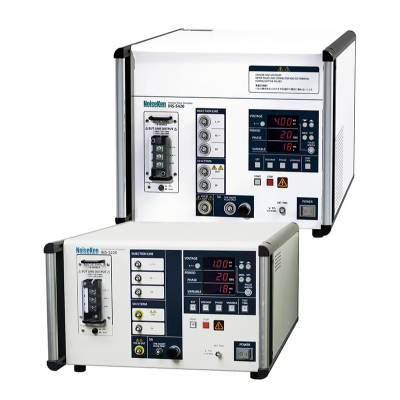EMC Test System

Noise Laboratory Co., Ltd is a Speicalist in Pulse EMI Simulation, For over 30 years from its foundation in 1975, Noise Laboratory has been focusing on immunity test equipment and related solutions. Now our product lines include various types of immunity test equipment ranging from those conforming to IEC 61000-4 series standards, other international or national immunity standards and even to customer’s in-house test standards.
PRODUCT RANGE
- Voltage Dip & Swell Simulator
- Electrostatic Discharge Simulator (ESS series)
- Impulse Noise Simulator (INS Series)
- Fast Transient Burst Simulator(FNS)
- Lightning Surge Simulator (LSS)
- Emission Measurement Equipment (EPS)
- Damped-Oscillatory Wave Simulator (SWCS)
- Automotive Transient Surge Simulator(ISS/JSS)
- Power Supply Voltage Fluctuation Simulator(SG)
- OTHER
ESD Simulators Product Overview
Static electricity is generated along objects moving and the objects consist of electric configuration of plus and minus. When this configuration falls into disorder and inclines to the one polarity, the static electricity is generated and this phenomenon is called as electrification. The electrification is generated as result of contact, rubbing and exfoliating mainly. Also, there is one another phenomenon which is called as induced electrification in the meaning of the static electricity.
In addition, although sometime, spark phenomena which may be generated when taking a sweater off and touching onto a door knob of a vehicle in dry condition are called as static electricity as well, it should be called as “Electrostatic discharge (ESD)” correctly. In our ordinary lives, 30kV electricity can be easily generated only with putting shoes on and walking on a carpet.
“NoiseKen” ESD simulators (ESS-S3011/ESS-B3011/) can reproduce and simulate the ESD from a charged human body intentionally for testing whether electronic equipments become malfunctioned or work correctly with the ESD influence, and the simulators conform to IEC61000-4-2 Standard which is standardized by International Electrotechnical Committee (IEC).
The malfunction mechanism is, when the ESD is realized to an electronic equipment, surface current flows on the body surface and the electric potential rises up. Consequently, electric potential of GND fluctuates and the subsequent electric/magnetic noises are generated. The noise flows into the inside and causes the malfunction due to coupling with the circuit (Please refer to the following figure). Since the phenomenon can be easily generated frequently, the test should be requisite to electronic equipment
ESD Simulator ESS-S3011A & GT-30RA
Free you from the hassle of testing by the pre-check function and the weight reduction of the discharge gun.
EMC test equipment to evaluate the resistibility of electronic equipment when energy charged on a human body or object is discharged to the electronic equipment.

ESD Simulator ESS-B3011A & GT-30RA
Cost-oriented basic model ESD Simulator equipped with the light weight discharge gun.
The output voltage can be selected up to max. 30 kV and compliant to both EN / IEC 61000-4-2 Standard and ISO 10605 Standard.

Lightning Surge Simulator (LSS)
A simulator to reproduce “High energy induced lightning noise” which is induced by potential change on the ground, or done to power lines or telephone lines as result of lightning current. This immunity test is required by major standards including IEC61000-4-5 and JEC 210/212 and is widely used in many industries.

Features
- Lightning surge simulator compliant with the IEC61000-4-5 Edition 3 requirements
- Maximum output voltage 15 kV (maximum coupling of 15 kV to AC / DC CDN and 6 kV to Telecom CDN) Enables to conduct the more extended reliability test including the destructive test
- Large size LCD for the operation is adopted for realizing better visibility and operatability
- Easy operation for the sequential tests with adoption of MPU control. Surge output / Waveform switching / Polarity switching / Sequence can be automated sequentially
- Selectable either MANUAL or PROGRAM mode MANUAL modes is used for the test according to the Standard or performing single conditioned test and PROGRAM mode can perform different conditioned tests sequentially so that the tests can be performed easily along purposes.
- Excellent safety with equipment of interlock
- Standard equipment of terminal for checking the waveforms:Enable to check the waveforms in connection to an oscilloscope with a BNC cable
- Isolation transformers available (Option)
- In order to avoid resonance with the power supply, possible to vary the constant of the decoupling network (1.5,1.3,1.0,0.8 mH) (Customized production). When some products like a power conditioner for photovoltaic application are connected to a lightning surge simulator, the resonant phenomena may occur and the products may not work well. In LSS-F03 series (with customization), possible to change constants of the inductances so as to avoid such problem
Automotive Transient surge simulator ISS-7600
This tester simulates various transient surge phenomenon noise in vehicles required by the international standard ISO 7637-2 (2011 version) and evaluates the resistance of on-board electronic devices.

Features
- Highly accurate output waveforms
- Waveforms guaranteed not only at the output terminal of each generator but also at the output terminal of the Coupling Network.
- Capable of running either as a system or as individual generators.
- PC Remote Control Software can control ISS-7600 through USB interface connection.
- Supports 12 V / 24 V / 42 V systems
- 60 V / 50 A big volume Coupling Networks available
- Up to 200 A Power supply available.
- Electric shock-free safety plugs are used for every output terminal.
- Load resistors meeting the loading conditions (specified in Annex D of the standard) for the verification of the output characteristics optionally available.
- Equipped with a high accuracy current monitor. An oscilloscope allows measurement of the current waveform flowing into the DUT. Current and voltage waveforms can be examined at the same time with an oscilloscope because the current monitor output circuit is floating with respect to the SG and FG. The monitor’s frequency response characteristic is from DC to 150 kHz.
- Japanese software is also available.
Emission Measurement System EPS-02Ev3
Three-Dimensional Indication (Time, Frequency, Amplitude) Simplifies EMC/EMI Debugging. EPS is a EMC/EMI debugging tool enabling designers to rapidly perform pre-measurement, failure point identification, and improvement efficiency confirmation in EMC/EMI countermeasure process of product design. How does it work? The software detects locations of probes by color discrimination through camera’s image sensors*, real time analysis measured signal frequency, shows a heat map by overlapping electromagnetic field strength and real images of measured objects.
*location detection method based on Patent Application 2007-223275 by National University Corporation Kanazawa University and Patent 5205547 by Noise Laboratory Co,. Ltd.

Features
- A real-time diagnostic tool supports EMC/EMI debugging.
- Fast visualize EMC/EMI problems.
- Enables easy comparison of countermeasures before and after.
- Capable of measurement from entire products to single components.
- Factor-editor function provides correction of antenna characteristics, cable loss and preamplifier.
- User friendly compact design.
- ustomer supplied spectrum and probes acceptable (Please consult)
Impulse Noise Simulator INS-S220 / S420
This Noise simulator simulates high frequency noises generated by ON/OFF switching at contact points of switches or relays, and arcs caused by electric motor, allowing to evaluate the resistibility of electric devices.
The Pulse contains wide range of frequency components and energy volume is changeable by adjusting pulse width. This allows conducting of highly-reproducible noise tests for noise troubles in the market.

Features
- Button touch instead of coaxial cable replacing reduces pulse width setting time.
- Pulse waveform stability has improved, allowing highly-reproducible testing.
- Consumable parts reduction cut down running cost.
- Common mode/normal modes are easily switched between by a short plug.
- “Test time setting” new function simplifies test time setting.
- Wiring became easier thanks to a built-in 50Ω terminator resistor design.
- Repetition cycle became faster. Due to high repetition, malfunction occurrence rate is up and test time is shortened.(only INS-S220)
- Outlet Panel allows direct connection of EUT AC plug.(option)
- Various tests are available by using different probes and coupling clamps.(option)
- Using of external CDN allows testing to 3-phase EUTs.(option)
- Dedicated software simplifies testing with various test conditions (option, applicable to INS-S420 only)